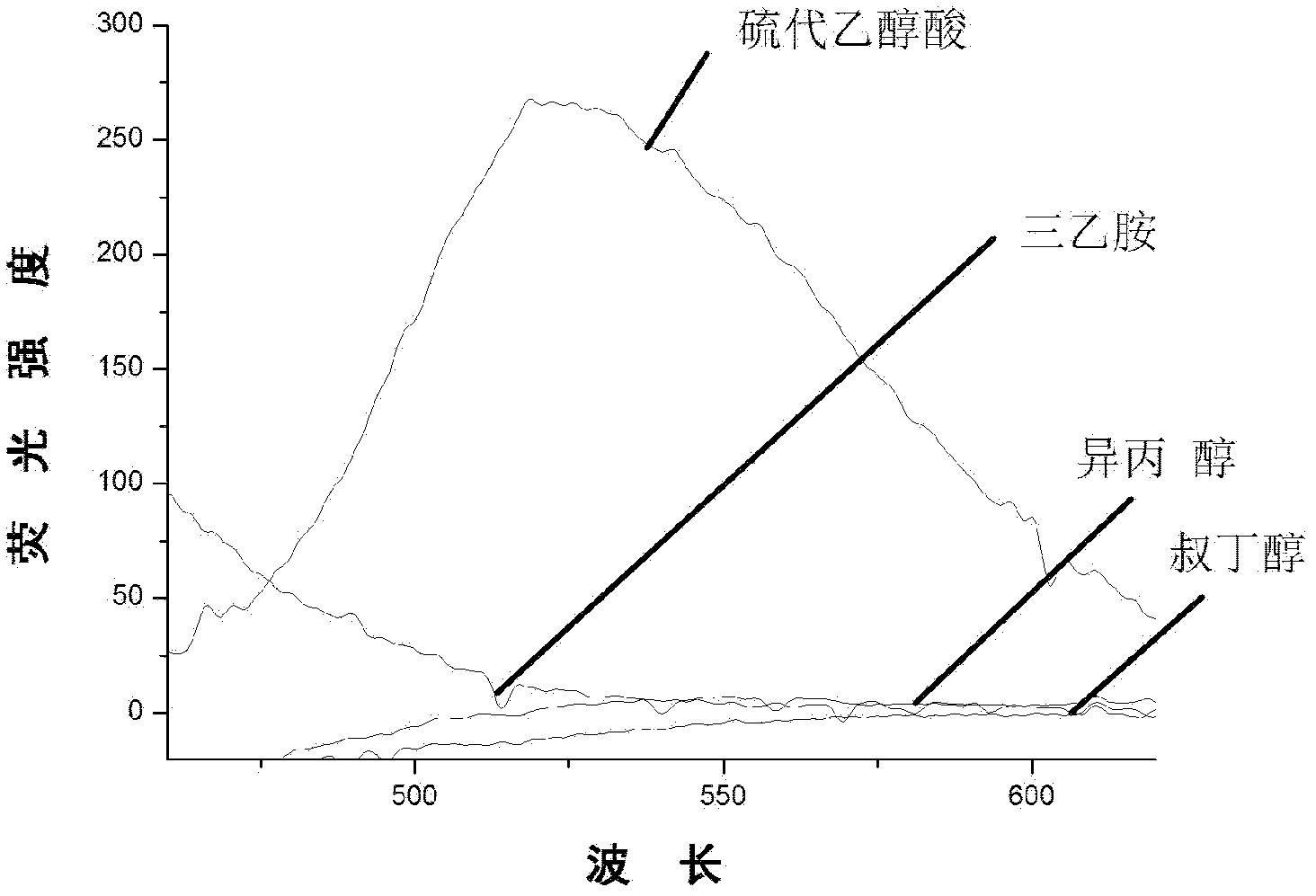Fluorescent probe for detecting mercapto compounds as well as preparation method and using method of fluorescent probe
A sulfhydryl compound and fluorescent probe technology, applied in the field of bioengineering, can solve the problems of low signal-to-noise ratio, high response probes are rare, poor photostability, etc., and achieve high sulfhydryl detection sensitivity, excellent selectivity, and easy synthesis. Effect
- Summary
- Abstract
- Description
- Claims
- Application Information
AI Technical Summary
Problems solved by technology
Method used
Image
Examples
Embodiment 1
[0035] (1) Preparation of probe molecules
[0036] The reaction process is represented by the following reaction scheme:
[0037]
[0038] Step 1, preparation of formula II: Dissolve 0.2 g of hydroquinone in 50 mL of dichloromethane, then add 0.6 mL of triethylamine, add 0.6 g of dansyl chloride at 0°C, and then stir the reaction at room temperature After 10 hours, after the reaction was completed, the solvent was evaporated to dryness and separated with a silica gel column.
[0039] Step 2, preparation of formula I: Dissolve 0.6 g of compound of formula II in 50 mL of dichloromethane, add 1.5 mL of triethylamine, stir for 5 minutes, then add dropwise 0.9 g of 2,4- Dinitrobenzenesulfonyl chloride dichloromethane solution 10 mL, after the dropwise addition is complete, continue to stir at room temperature for 10 hours, remove the solvent under reduced pressure, separate and purify the crude product by silica gel column chromatography, and use petroleum ether: ethyl acetate ...
Embodiment 2
[0052] (1) Preparation of probe molecules
[0053] Reaction process is with embodiment 1:
[0054] Step 1, preparation of formula II: Dissolve 0.3 g of hydroquinone in 50 mL of dichloromethane, add 0.6 mL of triethylamine, add 0.9 g of dansyl chloride at 0°C, and then stir the reaction at room temperature for 12 hour, after the reaction was finished, the solvent was evaporated to dryness and separated with a silica gel column;
[0055] Step 2, preparation of formula I: Dissolve 0.9 g of compound of formula II in 50 mL of dichloromethane, add 1.5 mL of triethylamine, stir for 5 minutes, then add dropwise 1.4 g of 2,4- Dinitrobenzenesulfonyl chloride dichloromethane solution 10 mL, after the dropwise addition is complete, continue to stir at room temperature for 12 hours, remove the solvent under reduced pressure, separate and purify the crude product by silica gel column chromatography, and use petroleum ether: ethyl acetate = 4:1 is the eluent elution, and the pure product o...
Embodiment 3
[0065] (1) Preparation of probe molecules
[0066] Reaction process is with embodiment 1:
[0067] Preparation of Formula II: Dissolve 0.4 g of hydroquinone in 50 mL of dichloromethane, add 0.6 mL of triethylamine, add 1.2 g of dansyl chloride at 0°C, then stir and react at room temperature for 15 hours, and wait for After the reaction was completed, the solvent was evaporated to dryness and separated with a silica gel column;
[0068] Preparation of Formula I: Dissolve 1.2 g of the compound of Formula II in 50 mL of dichloromethane, add 1.5 mL of triethylamine, stir for 5 minutes, then add dropwise 1.8 g of 2,4-dinitro 10 mL of dichloromethane solution of benzenesulfonyl chloride, after the dropwise addition is complete, continue to stir at room temperature for 15 hours, remove the solvent under reduced pressure, separate and purify the crude product by silica gel column chromatography, and use petroleum ether: ethyl acetate = 4:1 For the eluent elution, the pure probe mole...
PUM
 Login to View More
Login to View More Abstract
Description
Claims
Application Information
 Login to View More
Login to View More - R&D
- Intellectual Property
- Life Sciences
- Materials
- Tech Scout
- Unparalleled Data Quality
- Higher Quality Content
- 60% Fewer Hallucinations
Browse by: Latest US Patents, China's latest patents, Technical Efficacy Thesaurus, Application Domain, Technology Topic, Popular Technical Reports.
© 2025 PatSnap. All rights reserved.Legal|Privacy policy|Modern Slavery Act Transparency Statement|Sitemap|About US| Contact US: help@patsnap.com



